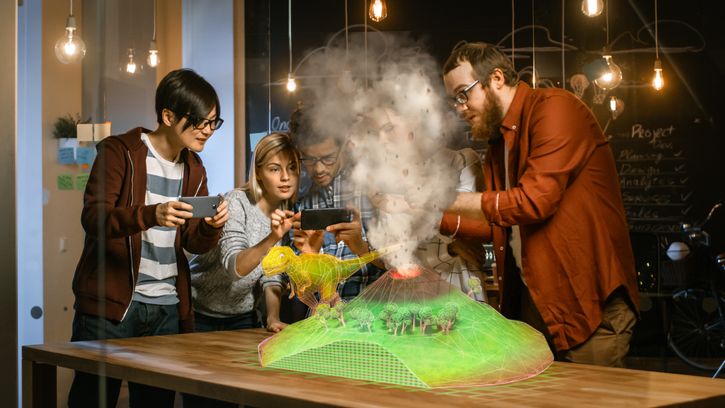
The augmented reality (AR) game phenomenon Pokémon Go has completely revolutionized the mobile app market. The game has made $1.8 billion in sales so far since its 2016 launch. And continues to gain popularity thanks to frequent updates. It’s a great example of what augmented reality can achieve and especially what it can look like. Your favorite animated creatures can literally be popping out of your local grocery store. And it’s only just one of the very first.
You may have heard of the recent WayRay announcement. To diversify its product portfolio, the Swiss company partnered with Porsche, Hyundai Motor, Alibaba Group, etc. WayRay’s Augmented Reality solutions aim to bring AR technology to a variety of industries. From transportation to smart glasses for businesses in the construction industry.
So what’s the hype of AR all about
What is “augmented reality”?
Let me break it down for you. AR uses immersive technology to blend software-generated elements into the real world. A great pop-culture-friendly example is Tony Stark’s Iron Man suit. Which is a real classic in AR-generated objects commingled in a real-life setting. In contrast to the more popular science fiction depiction of “virtual reality,” augmented reality simply adds to the reality that is already present around you. Many of its proponents say that it’s a means of making people interact with the world around them in richer ways. Which could very well be true. Augmented reality is in some sense a way of transforming the way you perceive reality.
Putting cinematic depictions aside, AR is the next big thing. As it finds increasing uses in healthcare, education, heavy machinery, visual arts, and pretty much anything else that comes to mind. There’s in fact, an entire fledgling industry of augmented reality games and apps that are still in various stages of development.
To show exactly what we mean when we say that AR has the potential to change the way you interact with the world, let’s look at the ways in which it is being used. These examples of augmented reality used in various industries can prove how the economy may be totally affected by this technology.
AR in Healthcare

Recently, imaging technology has gained popularity, particularly in the field of medicine. Using an optical head-mounted display during surgery can cut down on medical errors and time. Likewise, surgeons can now easily and concurrently browse vast amounts of anatomical data. In 2013, Google Glass, a forerunner in augmented reality heads-up displays, failed because it was developed too soon. However, as innovation and breakthroughs in technologies take place, Augmented Reality is predicted to play a vital role in the OR.
Obtaining electronic medical records will also become hassle-free with AR. Nurses and doctors can assist patients while obtaining relevant records in real-time on their smart glass. Thus reducing time spent on each patient and increasing overall efficiency.
Moreover, this technology has immense potential in teaching medical trainees. Inexperienced doctors can practice on simulated patient encounters, without putting actual lives in danger. After all, we are not talking about dissecting dead frogs here… no offense to the frogs!
With a promising future in the world of healthcare, AR can pave the way for safer and more efficient medical practices. The potential of using augmented reality-based apps to keep track of fitness, air quality, and calorie count could be an endless list of gimmicks. This can help improve the well-being of those who use such applications.
AR in Education
A study, Neuro-Insight showed the level of hippocampus activity when engaging with AR experiences. It demonstrated that it nearly tripled when compared to non-AR experiences.
AR has the potential to replace conventional methods of education. It can enhance the learning process by making it more interactive and creative. The integration of learning and creativity is a constant goal in the classroom. Hence, this is where revolutionary technology may have some application.
There are some great applications being developed by companies like Blipper and Math alive. These applications tend to increase student engagement within the classroom. For instance, Math alive will be introducing Student Journals. These journals use an engaging 3D AR experience to help students learn important math concepts.
Augmented Reality apps that prioritize learning experiences over lectures will also have an influence outside of the classroom. They are also likely to have an impact on distance learning. Imagine getting prompts about the historical events that shaped your neighborhood instead of walking around looking for Pokemon. This would imply that strolling down any random London street could also turn into a journey through the World War II neighborhoods of the city. Which will give us a visual of how they were impacted by Nazi air raids. That’s just an idea, but history buffs will undoubtedly use augmented reality for it in the future.
AR outside the classroom has a promising future as well. CASE – a Canadian tech company – transformed a local school gym wall into an augmented reality integrated ball game. Examples like these show that AR, if implemented properly, has a positive role to play in students’ ability to learn and grow.
AR in Construction/Heavy Equipment
Construction of heavy equipment is as heavy on the pocket, if not more. However, technological progress is shaping development costs, making prototyping, inspecting, and testing equipment more cost-effective and efficient.
You can now create 3D models and project them in different environments with ease, provided you have a good AR system in place. This can reduce construction and shipping costs drastically.
Caterpillar, a pioneer in manufacturing heavy equipment, shows how augmented reality apps can carry out repair audits and services. This is especially helpful for inexperienced engineers. Moreover, AR headsets used at job sites can enable better safety for workers, with in-built sensors and warning signals.
In short, reduce the hassle, use AR.
AR in Gaming

Mobile games are perhaps the most popular platforms for AR technology today. From catching cute Pokémon characters to killing gruesome zombies, AR gaming has extended the playing field to the environment around us.
And guess what? It’s much more budget-friendly than VR gaming. You can play AR games on any portable console, tablet, or smartphone without the need to buy expensive headsets.
Zombies, Run! Available for both iOS and Android users, this immersive game takes you on a mission to survive a zombie attack on your city. Add-ons in the game don’t just include images but sound as well.
Just put on your earphones and wear your running shoes, this game is going to make you run around the city. Just be careful, don’t bump into a pedestrian, or get hit by a car!
The Verdict
AR may currently be just on its training wheels.
But once properly implemented, it’s going to expand into every avenue of life.
Sounds exciting right? As great as shared social spaces with immersive technology sound, this may not be all good news for us. With greater access to our lived reality, security and privacy concerns are bound to rise. Therefore, with technological progress, developers need to incorporate ethical and safe practices.
“I do think that a significant portion of the population of developed countries, and eventually all countries, will have AR experiences every day, almost like eating three meals a day. It will become that much a part of you.” — Tim Cook
Fascinating, yet disconcerting.


